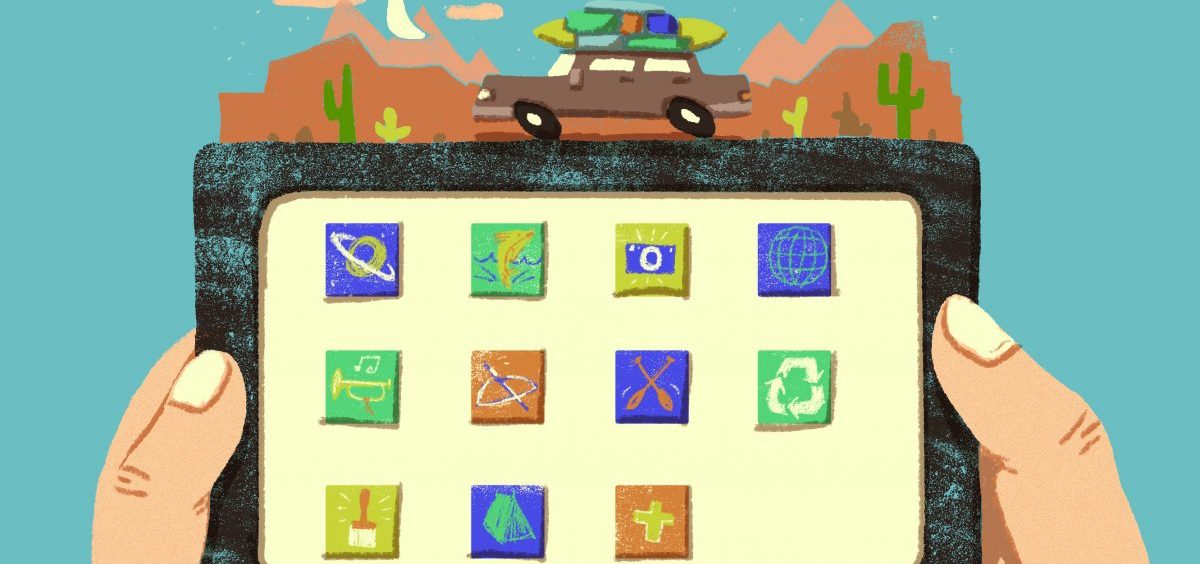News

Parents: Here’s How To Pick The Best Kids Apps For Family Vacations
By: Anya Kamenetz | NPR
Posted on:
An earlier version of this piece ran in June 2017.
It’s summer vacation season again and many families will be lucky enough to be heading off for at least a few days. At least half of parents say quality time together is the most important reason to take a family vacation, according to a national survey by the rental car company Alamo.
Still, there will inevitably be downtime: at airports, on planes, trains or in the backseat. So one new travel necessity is a tablet or smartphone loaded up for the kids with an extra charger or battery.
In an ideal world, our kids’ screen time won’t be a bleeping, blooping, brain-rotting distraction, but a creative and fun, even educational diversion. So NPR Ed reached out to some experts for recommendations and guidelines on helping pick the best apps, for backseat time or any time.
These recommendations come with an important caveat. The American Academy of Pediatrics’ latest guidelines on screen time for kids emphasize the need for balance with other activities. The goal for school-age children is at least 60 minutes of physical activity a day. Meals and other designated family activities should be screen-free time.
Joint media use is another best practice that the AAP recommends: That means playing games or watching videos alongside your kids and discussing the content. That said, in a backseat situation, that’s not always possible.
“There are plenty of casual games that will burn time, but ideally parents want something that will help their kids learn also,” says Christine Elgersma, who works in parent education for Common Sense Media. The nonprofit provides hundreds of free media reviews to families with information on fun, appropriateness and educational value.
So, here are the principles we came up with to guide your children in selecting the perfect apps to while away the time.
“Educational” doesn’t mean “drill and kill.”
For the youngest kids, ages 2-5, Elgersma recommends an app called Busy Shapes. “It’s puzzle-based and gets increasingly more challenging as kids play,” says Elgersma.
It’s developed by Edoki Academy, which has a group of apps that it says are based on the Montessori method of early childhood education. Montessori emphasizes self-directed and hands-on learning.
Even apps that get at specific skills should be more than digital worksheets, says Elgersma, citing e-learning research by Kathy Hirsh-Pasek at Temple University and others.
“If the experience can be replicated on paper, it doesn’t make sense on an app,” Elgersma says. “A great app offers an experience that can only be had on a screen.” She points to Motion Math, a group of apps that is being used in elementary school classrooms, and offers fun experiences like running a cupcake shop.
Open-ended play is enriching, too.
Children, especially young children, have a developmental need to play and use their imaginations.
Many of the most worthy apps for kids are better described as “a toy as opposed to a game,” in the words of Bjorn Jeffery, the former CEO and co-founder of Toca Boca. Toca Boca, one of the most award-winning app companies, is recommended highly by Elgersma. Their first app was Toca Tea Party, basically a play-pretend game, with no points or levels.
“It’s more similar to Lego,” says Jeffery. “You can’t win at Lego, it just is what it is.” In user testing of the tea party game, one surprising, and fun, change that preschoolers asked for was more spilling.
In this category, Elgersma also recommends My Playhome, which is like a digital dollhouse, and Me, by TinyBop, which is a personal scrapbook kids can fill in by answering questions and putting in videos and pictures.
Don’t underestimate the power of a good story.
Electronic devices are good for reading and listening, not just watching.
Amazon’s FreeTime Unlimited is one major subscription service. Epic! is another. Both include thousands of picture books, chapter books, graphic novels, and even cookbooks grouped by ages. Epic! features a nifty weekly progress email for grownups and some light “game” features that encourage kids to keep reading.
For pre-readers there are backseat options too. A recent brain study showed kids getting a lot out of narrated slideshows (which are available on Epic!, FreeTime Unlimited, YouTube and elsewhere), essentially the automated version of reading a book.
Audiobooks and podcasts are other possibilities that can be fun for the whole family.
Finally, Amazon’s FreeTime app has a “Learn First” feature that allows parents to mandate a certain amount of reading before switching to other screen-based pursuits.
Try an app that enhances your vacation experience.
Headed to an amusement park? Pango Build Park is an app for elementary schoolers that involves building roller coasters and other parts of a theme park — there’s a little mapmaking involved too.
Going camping? Toca Nature is aimed at kids older than age 4. Explore different habitats and get a gentle introduction to the food chain.
Going to the beach? A city? Tinybop has an “Explorer’s Library” series that includes Coral Reef and Skyscraper.
And, if you prefer old-fashioned, road-trip diversions, there are several free versions of the license plate game available for iPhone and Android, and a wide range of karaoke apps if singalongs are your thing. These can get the whole family involved together.
Watch out for ads and add-ons.
Some kids’ apps are free to play initially, but dangle all kinds of extra goodies that cost money. In 2017, Amazon was forced to refund over $70 million in in-app purchases made by children without their parent’s knowledge. Apple and Google have had to do the same in years past.
Elgersma says to look for apps that have a flat free or subscription model, maybe with a free trial so you can check it out before you commit. The iTunes store now provides a list of in-app purchases, so caveat emptor.
9(MDI4ODU1ODA1MDE0ODA3MTMyMDY2MTJiNQ000))

